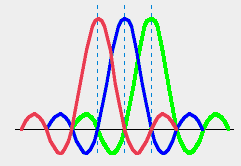OFDM |
Orthogonal Frequency Division Multiplexing (OFDM) is a transmission technology in which the data is divided over a large number of radio frequencies. Each radio frequencies carries only a small portion of the total amount of data. This makes the transmitted signal robust against frequency selective interference and fading, such as multipath fading. If frequency selective fading occurs on the radio channel only a small portion of the data is effected while in a broadband transmission with all data on a single carrier the complete radio-frequent signal would be effected.

In OFDM it is possible to place the radio frequent carriers very close to each other as long they are spaced in such a manner that they are orthogonal (independent) to each other.
Because of this robustness OFDM is used in broadband systems, such as digital TV en digital radio, in mobile systems, such as Flash OFDM, and in Radio LANs which have to operate in an environment with a lot of multipath fading.
OFDM is a technique that requires a lot of processing power. That is the reason that OFDM is used only since fairly recently.
COFDM
To cope with errors that occur due to the fact that one of the carriers is distorted, OFDM is often combined with coding. The combined technique of OFDM and coding is called COFDM.
Discrete MultiTone
The same principle as OFDM is also used in ADSL. Only in ADSL it is most often referred to as Discrete MultiTone (DMT).